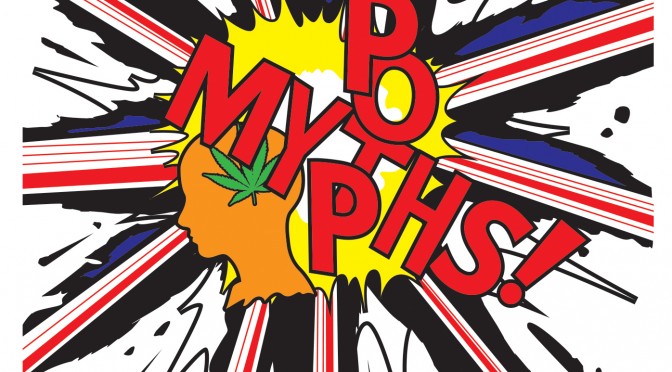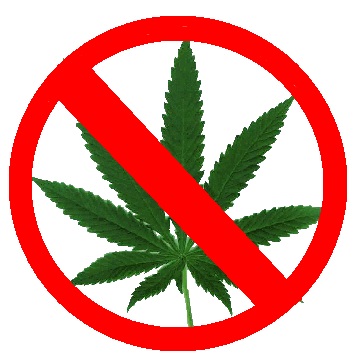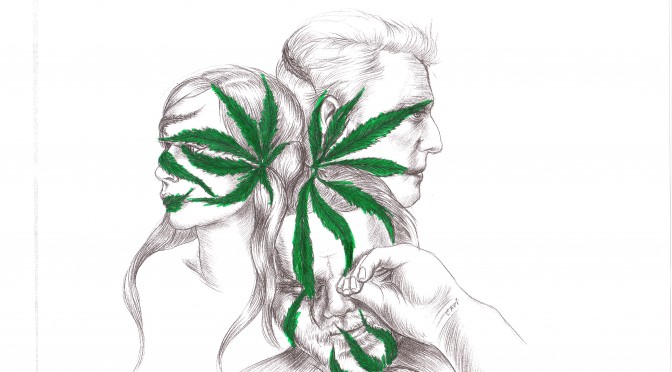In fact, about 15% of all users and a much higher percentage of heavy users will experience psychotic symptoms.1 Half of those individuals will become chronically schizophrenic if they don’t stop using.2 Fortunately, some do stop using because psychosis is not pleasant and they wisely recognize that pot caused their problems. Myth #2. Marijuana-induced psychosis must be due to other contaminating drugs.
Clinical studies under controlled laboratory conditions have shown that administering the pure, active ingredient of pot, ∆9-THC, elicits psychotic symptoms in normal volunteers.3 In addition, epidemiological research of nearly 19,000 drug abusing Finnish subjects showed that it was not LSD, amphetamine, cocaine, methamphetamine, PCP or opiates that most consistently led to a diagnosis of long term schizophrenia, it was marijuana.4 Thus, if you lace your LSD with marijuana, you are more likely to go psychotic. Myth #3. If marijuana is associated with the development of chronic psychosis (schizophrenia), it is only because the patients are self-medicating. Correlation does not equal causation.
Actually, four studies have been carried out in Europe to ask the question which comes first, the marijuana use or the schizophrenia. The research was designed to follow thousands of young teen subjects through a course of several years of their lives, and to ask if those who were showing symptoms of psychosis at study onset were more likely to begin smoking pot, or were those who were normal but began smoking pot during the course of the study more likely to become psychotic. Three of the studies5 convincingly showed that the evidence for marijuana triggering schizophrenia was strong, whereas the evidence for self-medication was weak. The fourth concluded that both were happening — marijuana was triggering psychosis and psychotic individuals were self-medicating.6 Myth #4. Those who become schizophrenic from marijuana use were destined to become so anyway because of their genes.
The truth of the matter is that no one is destined to become schizophrenic. Even in the case where one member of an identical pair of twins has schizophrenia, only about half the time does the other twin become schizophrenic as well.7 Thus, there is ample room for environmental factors like marijuana to make a difference between leading a normal life and not. Myth #5. Studies showing links between marijuana and psychotic disorders like schizophrenia are “cherry picked” to exclude negative studies.
A very large review of all relevant published papers was conducted by a group of researchers from around the world and published in the prestigious medical journal, The Lancet. No attempt was made to exclude results that were negative. The results they obtained by merging all the studies was that marijuana use approximately doubles the risk for schizophrenia.8 Later research has shown that the risk goes up to 6-fold if the use is heavy or if the pot is strong 9 (similar to the strength of marijuana that is coming out of Colorado now). Myth #6. Marijuana makes you mellow and less aggressive.
This is certainly not the case for the 15% who experience psychotic symptoms and the subgroup who then go on to develop a chronic psychosis. These individuals are up to 9-times more likely to commit serious acts of violence than people whose schizophrenia has nothing to do with drug use.10 Just a few of the very recent high profile cases here on the East Coast include January’s Columbia Mall shooter Darion Aguilar and “multiverse”-ranting Vladimir Baptiste, who drove a truck through a Towson, MD TV station in May. Somewhat less violent cases include White House episodes: Oscar Ortega, charged with shooting at the White House, ex-Navy Seal employee David Gil Wilkerson charged with threatening the life of the President and most recently, fence jumper Dominic Adesanya who is charged with attacking the White House guard dogs this October. In the Rocky Mountain region, soccer dad Richard Kirk became psychotic after his first use of marijuana edibles for his back pain, and while hallucinating that the world was going to end, shot his wife to death as his children listened through a closed door.On the West Coast, the mentally ill marijuana user Aaron Ybarra shot one student dead and wounded two others on the campus of Seattle Pacific University. In Ottawa this past week, rifleman Michael Zehaf-Bibeau was originally thought to have terrorist ties after he killed a young guard at the Capitol, but instead his friends paint a picture of psychosis and law enforcement records reveal more than one arrest for marijuana possession. All of these individuals exhibited psychotic symptoms prior to their acts and their mental illness could be traced to their marijuana habit in my opinion. Myth #7. Marijuana is good for the symptoms of PTSD and by keeping this drug from our veterans, we are depriving them of an important alternative treatment.
Veterans Affairs Administration studies have shown that those with PTSD who smoke marijuana make significantly less progress in overcoming their condition.11 PTSD victims are already more vulnerable to psychosis and it comes as no surprise that clinicians have witnessed psychotic breaks in PTSD patients who begin marijuana12 because of the abundant literature showing an association between marijuana use and the subsequent development of psychosis. While the symptoms that afflict PTSD patients (anxiety, depression, panic) may be temporarily relieved while the subjects are “high”, these very same symptoms are exacerbated in the long run.13 Even in the context of polydrug use, it is the degree of marijuana use that correlates most significantly with anxiety and depression.14 Myth #8. Marijuana is less dangerous than alcohol and will reduce alcohol consumption, so we’ll end up with safer roadways.
In terms of mental health, marijuana is more dangerous on all counts (depression, anxiety, panic, psychosis, mania). As far as our roadways go, marijuana all by itself impairs driving. Whether it is better or the same as alcohol in that regard is still a matter of debate. What is known is that users all too frequently do both, and this combination is particularly hazardous. The interaction between the two drugs is synergistic,15 not additive. So you end up with someone who is wildly impaired. Myth #9. Laws don’t make a difference to rates of marijuana use
Some of the best data available on youth use in regards to laws comes from Europe, where they have a wide range of marijuana laws between the countries. The European organization ESPAD has studied youth use (15 to 16 year olds) across different countries every four years. The two most recent ESPAD reports (2007 and 2011) show that countries with legalization or defacto legalization (The Netherlands, Czech Republic, Italy, Spain) have on average a 3-fold higher rate of youth use than countries in which it has remained illegal. In our country, differences in decriminalization laws have existed between states for several years. If you break out the states with lenient decriminalization laws that also submit data to the CDC to track youth use (CO, AK, MA, ME), their rate of youth use (9-12th grade) is significantly higher (~25% higher) than states that have strict decriminalization codes and report to the CDC. Lenient codes include a low civil fine with no increase in penalties for repeat offenders, no requirement for drug education, no requirement for drug treatment, and no community service. Outright legalization and dedicated recreational pot shops in this country has not been around long enough for the effect on youth use to be determined. Myth #10. The Drug War on marijuana is too expensive.
It is hard to put a price on the damage done to someone’s life if they develop a chronic psychosis like schizophrenia or psychotic bipolar disorder. But if economics must be considered, the cost of just schizophrenia alone to our country is approximately $64 billion per year, accounting for treatment, housing and lost productivity.16 If all adults were exchange their glass of wine or two over the weekend for a joint or two, our rate of schizophrenia would be expected to double. That $64 billion per year would pay for the drug war on marijuana and much more. Brief Bio for the author: Dr. Christine L. Miller obtained her B.S. degree in Biology from the Massachusetts Institute of Technology and her Ph.D. degree in Pharmacology from the University of Colorado Health Sciences Center. For over twenty years she has researched the molecular neuroscience of schizophrenia, ten of those years at Johns Hopkins University. She is semi-retired, conducting occasional biomedical consulting on medical cases and an active volunteer for SAM-Maryland (Smart Approaches to Marijuana). Citations:
- Thomas H. A community survey of adverse effects of cannabis use. Drug Alcohol Depend. 1996 Nov;42(3):201-7. Smith MJ, Thirthalli J, Abdallah AB, Murray RM, Cottler LB. Prevalence of psychotic symptoms in substance users: a comparison across substances. Compr Psychiatry. 2009 May-Jun;50(3):245-50. Barkus EJ, Stirling J, Hopkins RS, Lewis S. Psychopathology. Cannabis-induced psychosis-like experiences are associated with high schizotypy 2006;39(4):175-8…………….. ↩
- Arendt M, Mortensen PB, Rosenberg R, Pedersen CB, Waltoft BL. Familial predisposition for psychiatric disorder: comparison of subjects treated for cannabis-induced psychosis and schizophrenia. Arch Gen Psychiatry. 2008;65(11):1269-74. Niemi-Pynttäri JA, Sund R, Putkonen H, Vorma H, Wahlbeck K, Pirkola SP. Substance-induced psychoses converting into schizophrenia: a register-based study of 18,478 Finnish inpatient cases. J Clin Psychiatry. 2013 74(1):e94-9…………….. ↩
- D’Souza DC, Perry E, MacDougall L, Ammerman Y, Cooper T, Wu YT, Braley G, Gueorguieva R, Krystal JH. The psychotomimetic effects of intravenous delta-9-tetrahydrocannabinol in healthy individuals: implications for psychosis. Neuropsychopharmacology. 2004 Aug;29(8):1558-72. Morrison PD, Nottage J, Stone JM, Bhattacharyya S, Tunstall N, Brenneisen R, Holt D, Wilson D, Sumich A, McGuire P, Murray RM, Kapur S, Ffytche DH. Disruption of frontal θ coherence by Δ9-tetrahydrocannabinol is associated with positive psychotic symptoms. Neuropsychopharmacology. 2011;;36(4):827-36. Bhattacharyya S, Crippa JA, Allen P, Martin-Santos R, Borgwardt S, Fusar-Poli P, Rubia K, Kambeitz J, O’Carroll C, Seal ML, Giampietro V, Brammer M, Zuardi AW, Atakan Z, McGuire PK. Induction of psychosis by Δ9-tetrahydrocannabinol reflects modulation of prefrontal and striatal function during attentional salience processing. Arch Gen Psychiatry. 2012 Jan;69(1):27-36……………. ↩
- Niemi-Pynttäri JA, Sund R, Putkonen H, Vorma H, Wahlbeck K, Pirkola SP. Substance-induced psychoses converting into schizophrenia: a register-based study of 18,478 Finnish inpatient cases. J Clin Psychiatry. 2013 74(1):e94-9……………… ↩
- Arseneault L, Cannon M, Poulton R, Murray R, Caspi A, Moffitt TE, 2002, Cannabis use in adolescence and risk for adult psychosis: longitudinal prospective study.BMJ. 2002 Nov 23;325(7374):1212-3. Henquet C, Krabbendam L, Spauwen J, et al. Prospective cohort study of cannabis use, predisposition for psychosis, and psychotic symptoms in young people. BMJ. 2005;330:11–15. Kuepper R, van Os J, Lieb R, Wittchen HU, Höfler M, Henquet C. Continued cannabis use and risk of incidence and persistence of psychotic symptoms: 10 year follow-up cohort study.BMJ. 2011 Mar 1;342: d738……………. ↩
- Griffith-Lendering MF, Wigman JT, Prince van Leeuwen A, Huijbregts SC, Huizink AC, Ormel J, Verhulst FC, van Os J, Swaab H, Vollebergh WA. Cannabis use and vulnerability for psychosis in early adolescence–a TRAILS study. Addiction. 2013 Apr;108(4):733-40…………….. ↩
- Gottesman, I.I., Shields, J.,1967. A polygenic theory of schizophrenia. Proc. Natl. Acad. Sci. U.S.A. 58,199-205…………… ↩
- Moore TH, Zammit S, Lingford-Hughes A, et al. Cannabis use and risk of psychotic or affective mental health outcomes: a systematic review. Lancet. 2007;370:319–328…..… ↩
- Zammit S, Allebeck P, Andreasson S, Lundberg I, Lewis G, 2002, Self reported cannabis use as a risk factor for schizophrenia in Swedish conscripts of 1969: historical cohort study. BMJ. 2002 Nov 23;325(7374):1199. DiForti M, Morgan C, Dazzan P, Pariante C, Mondelli V, Marques TR, Handley R, Luzi S, Russo M, Paparelli A, Butt A, Stilo SA, Wiffen B, Powell J, Murray RM. High-potency cannabis and the risk of psychosis. Br J Psychiatry. 2009,195(6):488-91..……… ↩
- Fazel S, Långström N, Hjern A, Grann M, Lichtenstein P. Schizophrenia, substance abuse, and violent crime. JAMA. 2009 May 20;301(19):2016-23. Harris AW, Large MM, Redoblado-Hodge A, Nielssen O, Anderson J, Brennan J. Clinical and cognitive associations with aggression in the first episode of psychosis. Aust N Z J Psychiatry. 2010 Jan;44(1):85-93..…… ↩
- Bonn-Miller, Marcel O.; Boden, Matthew Tyler; Vujanovic, Anka A.; Drescher, Kent D. : Prospective investigation of the impact of cannabis use disorders on posttraumatic stress disorder symptoms among veterans in residential treatment. Psychological Trauma: Theory, Research, Practice, and Policy, Vol 5(2), Mar 2013, 193-200………. ↩
- Pierre JM. Psychosis associated with medical marijuana: risk vs. benefits of medicinal cannabis use. Am J Psychiatry. 2010 May;167(5):598-9. ……… ↩
- Kuepper R, van Os J, Lieb R, Wittchen HU, Höfler M, Henquet C. Continued cannabis use and risk of incidence and persistence of psychotic symptoms: 10 year follow-up cohort study.BMJ. 2011 Mar 1;342: d738. Moore TH, Zammit S, Lingford-Hughes A, et al. Cannabis use and risk of psychotic or affective mental health outcomes: a systematic review. Lancet. 2007;370:319–328. Zuardi AW, Shirakawa I, Finkelfarb E, Karniol IG. Action of cannabidiol on the anxiety and other effects produced by delta 9-THC in normal subjects. Psychopharmacology (Berl). 1982;76(3):245-50. Patton GC, Coffey C, Carlin JB, Degenhardt L, Lynskey M, Hall W. Cannabis use and mental health in young people: cohort study. BMJ. 2002;325(7374):1195-8. Hayatbakhsh MR, Najman JM, Jamrozik K, Mamun AA, Alati R, Bor W. Cannabis and anxiety and depression in young adults: a large prospective study.J Am Acad Child Adolesc Psychiatry. 2007;46(3):408-17. Hasin DS, Keyes KM, Alderson D, Wang S, Aharonovich E, Grant BF. Cannabis withdrawal in the United States: results from NESARC. J Clin Psychiatry. 2008;69(9):1354-63. Buckner JD, Leen-Feldner EW, Zvolensky MJ, Schmidt NB. The interactive effect of anxiety sensitivity and frequency of marijuana use in terms of anxious responding to bodily sensations among youth. Psychiatry Res. 2009;166(2-3):238-46. Zvolensky MJ, Cougle JR, Johnson KA, Bonn-Miller MO, Bernstein A. Marijuana use and panic psychopathology among a representative sample of adults. Exp Clin Psychopharmacol. 2010 Apr;18(2):129-34……………. ↩
- Medina KL, Shear PK. Anxiety, depression, and behavioral symptoms of executive dysfunction in ecstasy users: contributions of polydrug use. Drug Alcohol Depend. 2007 Mar 16;87(2-3):303-11……… ↩
- Ramaekers JG, Robbe HW, O’Hanlon JF. Marijuana, alcohol and actual driving performance. Hum Psychopharmacol. 2000 Oct;15(7):551-558.
O’Kane CJ, Tutt DC, Bauer LA. Cannabis and driving: a new perspective. Emerg Med (Fremantle). 2002 Sep;14(3):296-303. Biecheler MB, Peytavin JF; Sam Group, Facy F, Martineau H. SAM survey on “drugs and fatal accidents”: search of substances consumed and comparison between drivers involved under the influence of alcohol or cannabis. Traffic Inj Prev. 2008 Mar;9(1):11-21……… ↩ - Wu EQ, Birnbaum HG, Shi L, Ball DE, Kessler RC, Moulis M, Aggarwal J. The economic burden of schizophrenia in the United States in 2002. J Clin Psychiatry. 2005 Sep;66(9):1122-9. ↩




